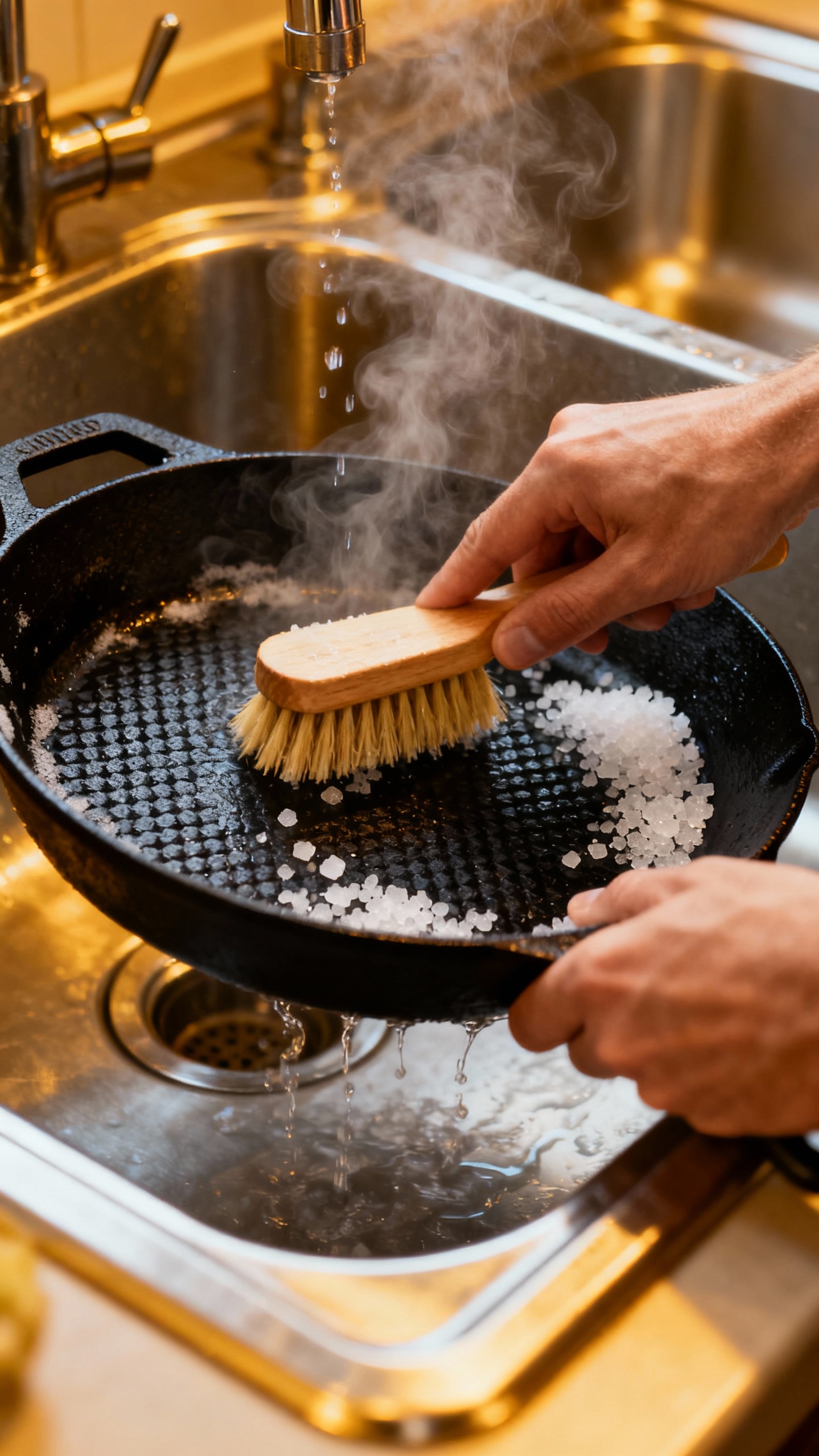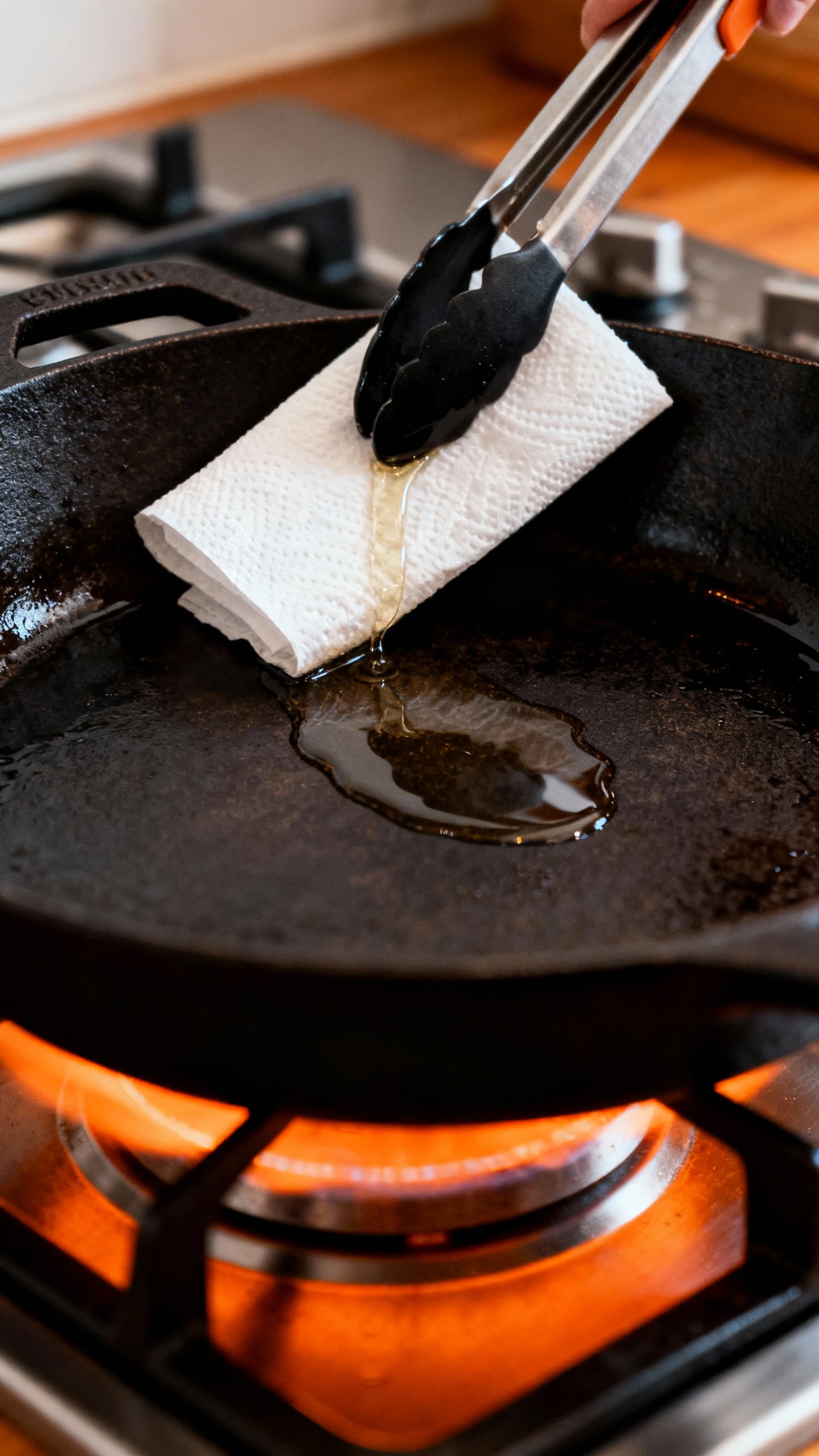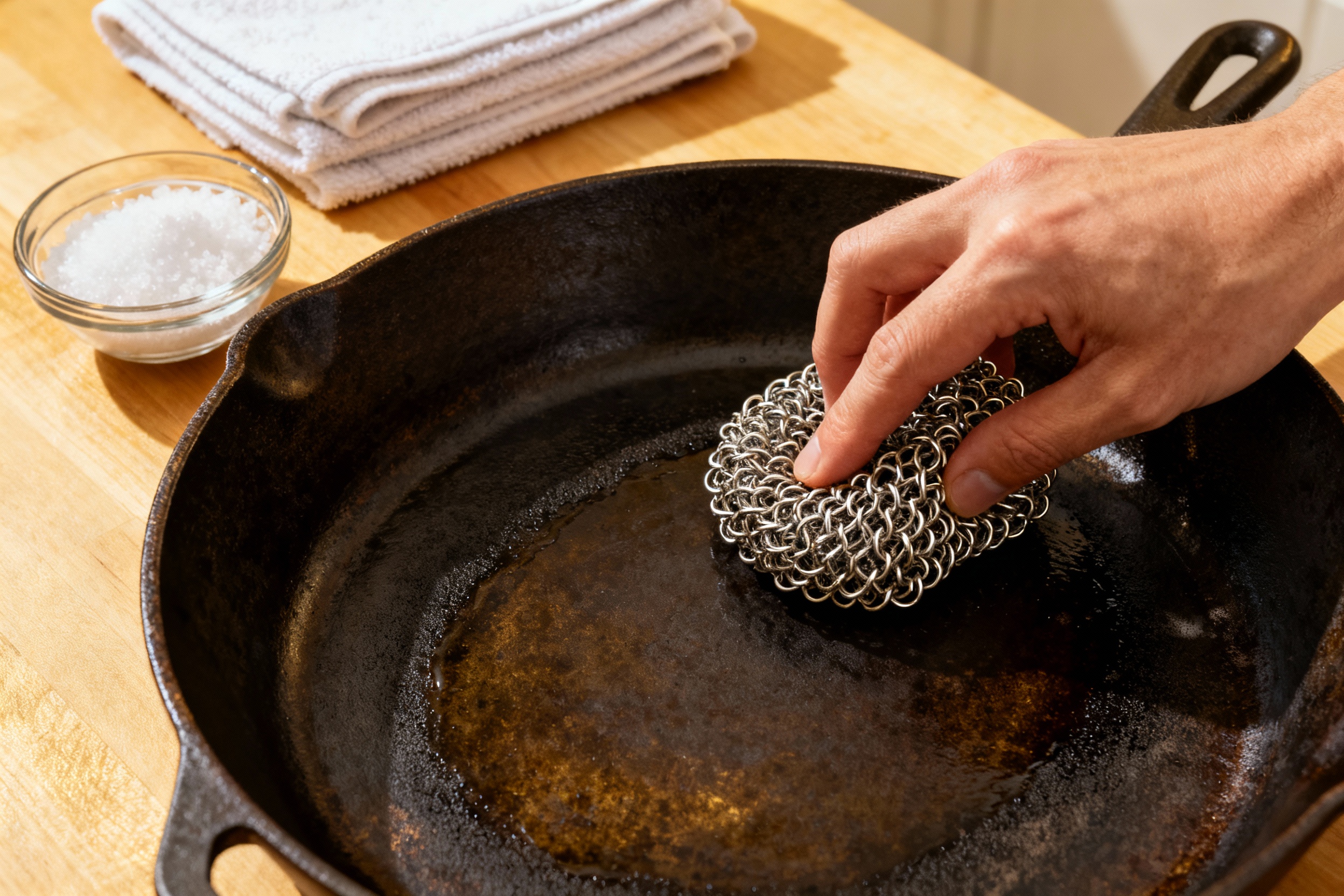Nothing panics a cast iron newbie faster than a stuck-on mess and a fear of wrecking that precious seasoning. Good news: you can scrub, rinse, and even use soap without nuking the pan’s nonstick mojo. The trick?
Use the right tools, a bit of heat, and a tiny splash of oil. Let’s get your skillet clean and happy without starting from seasoning zero.
What Seasoning Actually Is (And Why You Should Care)

Seasoning isn’t magic. It’s polymerized oil—oil heated until it bonds to the iron and forms a slick, durable layer.
That layer makes food release easier and protects against rust. So, when you clean cast iron, you’re not babying some fragile coating. You’re preserving a tough film of baked-on oil. That means gentle cleaning helps, but cast iron isn’t glass—don’t treat it like it’ll shatter if you sneeze.
Your Post-Cook Cleaning Routine: Simple, Fast, Effective
You just cooked.
The pan looks…lived-in. Do this before you start spiraling:
- Let it cool slightly. Warm (not blazing hot) pans clean easier.
- Rinse with hot water. Hot water loosens stuck bits fast.
- Scrub with a brush or non-scratch pad. Nylon brush, chain mail scrubber, or a scrubby sponge works.
- Tough gunk? Add a spoonful of coarse salt and a splash of water, then scrub. It’s like a mini exfoliation for your skillet.
- Dry completely. Towel dry, then put it on low heat for a minute or two to chase off lingering moisture.
- Wipe on a thin layer of oil. A few drops.
Wipe until the surface looks dry, not greasy.
That’s it. This routine keeps your seasoning intact and your pan ready for the next meal.
What About Soap?
FYI: a little mild dish soap won’t ruin seasoning. It won’t dissolve polymerized oil. Use soap if your pan feels greasy or smells like last night’s salmon.
Just don’t soak it, and rinse well.

When Food Won’t Budge: The “Boil-and-Scrape” Method
Some meals cling like a stage-five clinger (looking at you, melted cheese). Use heat to win the breakup.
- Add water to the pan to cover the stuck bits.
- Simmer for 3–5 minutes. The heat will soften the residue.
- Scrape with a wooden spatula or a plastic scraper to lift debris.
- Dump the water, rinse, and scrub lightly.
- Dry and oil as usual.
This method keeps your seasoning safe and saves your sanity.
Still Stuck? Try the Oil Swirl
For stubborn sticky patches, warm the pan, add a teaspoon of oil, and scrub with a paper towel held by tongs.
Heat plus oil dissolves clingy bits. It’s weirdly satisfying.
What Not To Do (Unless You Enjoy Re-Seasoning)
Sometimes the simplest “don’ts” save the day. Here’s what to avoid:
- Don’t soak your skillet for hours.
Water equals rust.
- Don’t put it in the dishwasher. Ever. That’s how villains clean cast iron.
- Don’t use harsh abrasives like steel wool on a well-seasoned pan unless you plan to re-season.
- Don’t store it wet or with the lid on. Moisture causes rust faster than you can say “why is it orange?”
- Don’t use tons of oil after cleaning. Thin coat only.
If it looks shiny-wet, you used too much.
Drying and Oiling: The Two-Step You Shouldn’t Skip
After you rinse and scrub, moisture lurks. You must kick it out.
- Heat-dry on the stovetop. Low heat for a minute or two until the pan looks bone-dry.
- Rub in a whisper of oil. Canola, grapeseed, or flax oil works. Wipe with a paper towel until the surface looks matte. No drips, no tackiness.
This quick finish protects the metal and refreshes the seasoning.
IMO, this two-step is the difference between a great pan and a rusty disappointment.
How Much Oil Counts as “Thin”?
Think 4–6 drops for a 10–12 inch skillet. Spread it everywhere—cooking surface, sides, and even the bottom. Then wipe again with a clean towel to remove excess.
If it feels sticky later, you used too much.
What If You Mess Up? Recovery Mode
Stuff happens. Maybe you left it wet.
Maybe the dishwasher “accidentally” happened. You can fix it.
Light Rust
– Scrub with a non-scratch pad or a bit of fine steel wool and a drop of dish soap. – Rinse, dry on heat, then oil lightly. – Cook something fatty next time (bacon, sausages) to rebuild seasoning. Yum and functional.
Patchy or Sticky Seasoning
– Heat the pan to warm, then wipe with a clean dry paper towel to remove sticky oil. – If patches look dull, rub a teaspoon of oil over the whole pan, wipe off thoroughly, and bake it upside down at 450°F (232°C) for 1 hour.
Let it cool in the oven. – Repeat if needed. It’s a quick refresh, not a full reset.
Total Strip and Re-Season (Worst Case)
– Remove all seasoning with steel wool or oven cleaner, rinse well, and dry. – Bake on thin coats of oil 2–3 times at 450–500°F (232–260°C) for 1 hour each, cooling in between. – FYI: You almost never need this unless the pan looked like a shipwreck.
Special Situations: Smells, Acidic Foods, and Sticky Messes
Some cooks avoid tomato sauces or wine reductions in cast iron. You don’t need to panic, but you should know:
- Strong odors (fish, curry) linger.
Use soap, rinse hot, and do a quick oil wipe. Heat-dry to chase the smell.
- Acidic foods can strip weak seasoning if you simmer for a long time. Short cooks are fine.
For long tomato braises, use stainless.
- Eggs sticking? Preheat longer and use more fat. Eggs need a hot, well-oiled surface and a little patience.
Preheating 101 (Because It Matters)
Cast iron loves a slow warm-up. Heat on medium for 3–5 minutes before cooking.
When a drop of water skitters, you’re good. Food sticks less, seasoning stays happier, and you look like a pro.
FAQs
Will soap ruin my seasoning?
No. Modern dish soap doesn’t strip hardened, polymerized oil.
Use a small amount when needed, rinse well, and oil after drying. Your seasoning will survive just fine.
Can I use metal utensils?
Yes, with reasonable care. A metal spatula with a smooth edge works well and even helps keep the surface smooth.
Don’t hack at it with a knife like you’re mining for ore.
How do I stop rust for good?
Keep it dry, heat-dry after washing, and apply a very thin oil coat. Store in a dry spot with the lid off. If humidity’s high, tuck a paper towel inside to absorb moisture.
Simple, boring, effective.
What’s the best oil for seasoning?
Any neutral, high-smoke-point oil works: canola, grapeseed, sunflower. Flax oil polymerizes hard but can flake if applied too thick. The real secret is thin coats, not exotic oil.
Why does my pan feel sticky after I oil it?
You used too much oil or didn’t heat it enough afterward.
Wipe off the excess and warm the pan for a minute. If it stays tacky, bake it at 450°F for an hour to cure the film. Lesson learned: less is more.
Can I clean cast iron with salt only?
Absolutely.
Salt makes a gentle abrasive. Add a spoonful to the warm pan, scrub with a paper towel or cloth, rinse, dry, and oil. It’s old-school and it works.
Conclusion
You don’t need mythical techniques to keep cast iron happy—just hot water, a scrubber, proper drying, and a whisper of oil.
Clean it warm, avoid long soaks, and don’t fear a little soap. When problems pop up, fix them fast and move on. Keep cooking, keep it simple, and your skillet will outlast your stovetop—IMO, that’s a pretty solid kitchen win.


